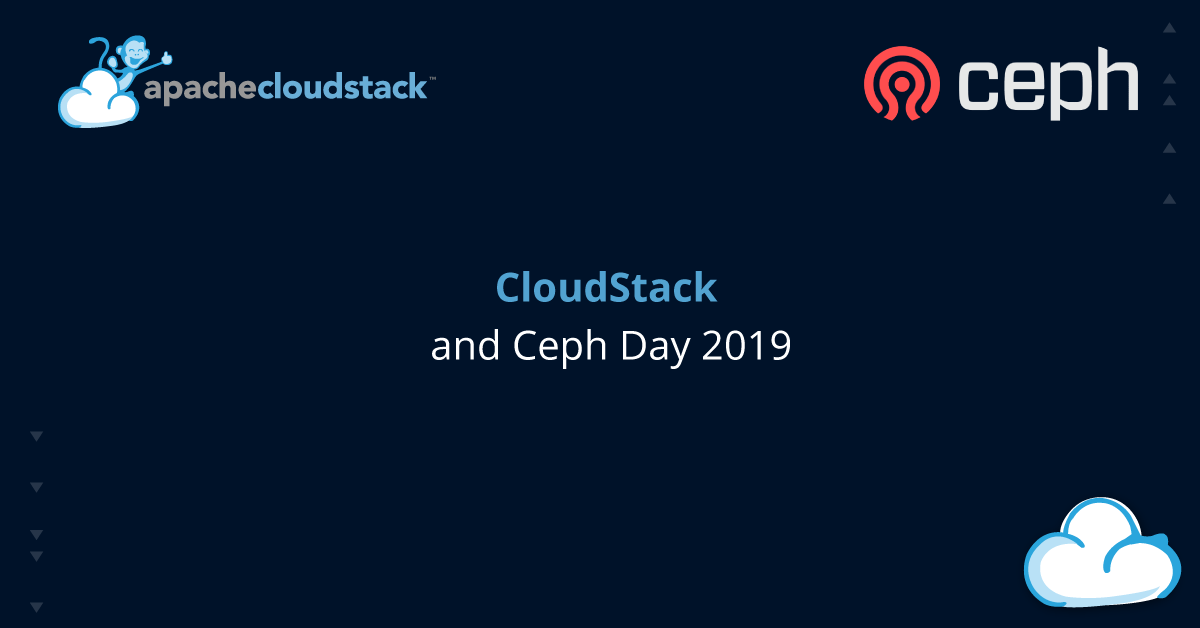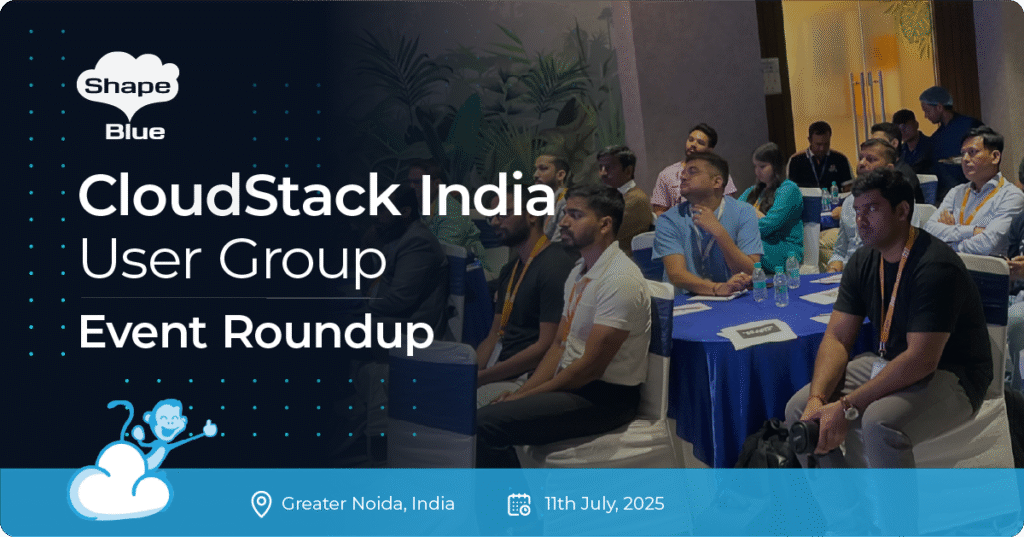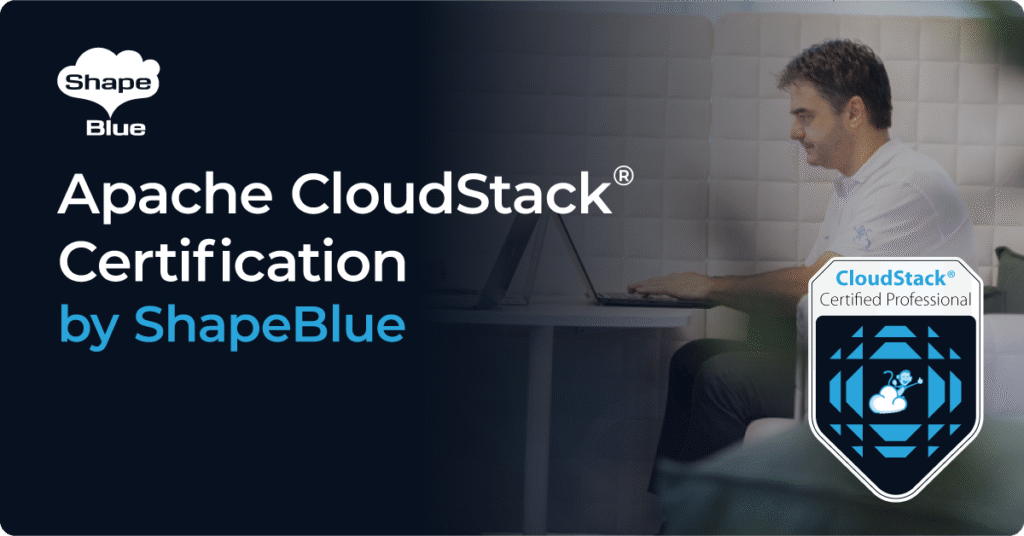On Thursday, October 24 2019 the CloudStack community joined up with the Ceph community for a combined event in London, and it was another super day! The meetup took place at Student Central (formerly University of London Union) on a crisp London day, and registration started early with people enjoying coffee and pastries whilst greeting friends and colleagues. The morning was a mixture of Ceph and CloudStack talks, and the afternoon was split into two tracks – one devoted to Ceph and the other to CloudStack.
All the day’s talks were recorded, and all video can be found here. Links to all presentation slides can be found at the bottom of this article.
CloudStack & Ceph combined morning sessions
Once everyone had enjoyed breakfast, Wido den Hollander (of 42on) and I (Steve Roles, ShapeBlue) took to the podium to welcome everyone, explain a bit about how the event had come about (only the second such combined event, the first was April 2018), and talk a little about both technologies (CloudStack and Ceph) and how well they work together.
Having set the scene Wido was ready to deliver the first presentation of the day, which was prepared to appeal to both communities – ‘Deploying CloudStack and Ceph with flexible VXLAN and BGP networking’. This first talk really got the event off to a flying start, with plenty of questions and interaction from the floor.
Next up was Venko Moyankov (Storpool), with a talk entitled ‘Achieving the ultimate performance with KVM’. Venko talked through private cloud setup with KVM achieving 1M IOPS per hyper-converged (storage+compute) node, posing (and answering) the question: What is the optimum architecture and configuration for performance and efficiency?
After a short break, it was the turn of Andrija Panic (ShapeBlue) to present ‘Ceph with CloudStack’. In this presentation, Andrija gave a brief introduction to Ceph and covered some considerations around its architecture, both in general and related to CloudStack.
CloudStack afternoon sessions
After lunch, the day split into two separate tracks, the first dedicated to CloudStack (the CloudStack European User Group – CSEUG), the second to Ceph. As with the morning, both rooms were very busy with full agendas. As I focused on CloudStack, I cover the CloudStack talks here (at the end of the article I include links to all Ceph presentations).
In the absence of Giles Sirett (CSEUG chairman), I stepped up to talk about CloudStack news, which (as always) there is lots of, including new releases – 4.12, 4.11.3 (LTS), and 4.13 (LTS). I touched on some of the new features introduced in these releases, and also talked a little about what’s coming in the next LTS (Jan / Feb 2020 – 4.14). I won’t go into detail as that was the job of my colleague Andrija in a later talk. I mentioned the recent fantastic CloudStack Collaboration Conference in Las Vegas (all recorded talks can be found here) and that the next CSEUG meetup will likely be in February 2020, and will be in Berlin, hosted by out friends from iTelligence. Registration will be open soon, and please contact me if you would like to give a talk.
I then introduced the first talk of the CloudStack track, welcoming Andre Walter and Sebastien Bretschneider (iTelligence) with ‘Cloud Management Portal – Admin View’. Another great talk for both communities with a technical overview showing how iTelligence as a cloud service provider use CloudStack & Ceph and how they extended their infrastructure with additional service components to enhance their cloud service portfolio.
Next up was Slavka Peleva (also of Storpool) with a talk entitled ‘Storage-based Snapshots for KVM VMs in CloudStack’. Slavka talked us through this feature, starting with VM & disk / volume snapshots, before explaining in detail the solution of employing the underlying storage provider’s capability to create, revert and delete disk snapshots.
As mentioned earlier, next up was Andrija Panic (ShapeBlue), with ‘New stuff in CloudStack!’ Andrija went through new user features, operator features and integrations such as… VM Ingestion, Backup & Recovery framework, Vmware 6.7 support, Kubernetes integration, and of course – a new, modern UI for CloudStack. This demonstrated just how much work and development is going into CloudStack, and if you are interested to see just how much work and development, I urge you to read through Andrija’s comprehensive slides, and watch his video:
After a short break, we welcomed Graeme Wright (Smart Communications) with his talk ‘Our journey with CloudStack’. This sort is talk is always fascinating, as everyone has a slightly different journey and reasoning behind technology decisions. The questions Graeme answered: Why we chose CloudStack for Smart Communications… How we use CloudStack and the features we employ… What CloudStack enables us to achieve for our cloud solution.
The last talk of the day was Sven Vogel (EWERK ) with ‘Running OpenShift Clusters in a Cloudstack Environment’. This talk provided an insight into the way in which EWERK run OpenShift (kubernetes) Clusters on Cloudstack.
The end of this last talk of the CloudStack track coincided with the end of the last Ceph talk next door, so we all congregated together to hear some last thoughts and acknowledgements from Wido. This was the second collaborative day between Ceph and CloudStack, and much like the first it was a resounding success, thanks in no small part to the vibrant communities that support these technologies. This will now be an annual event, with the next one provisionally scheduled for October 2020.
Bringing the event to a close, we all moved the conversations downstairs to the bar (a definite advantage of holding the event at a student union), where the event continued late into a busy London evening.
Thanks to our sponsors, without which these great events wouldn’t be possible – Softiron and the Ceph Foundation (for providing the venue and catering), the State51 Music Group (for buying drinks in the bar afterwards) and 42on for helping with organisation and logistics. And of course – thanks to the day’s speakers, many of whom traveled from afar (Amsterdam, Bulgaria, Serbia, Germany) to give their time and expertise freely. Hope to see you next time!
All presentation slides:
Deploying CloudStack and Ceph with flexible VXLAN and BGP networking
Venko Moyankov: Achieving the ultimate performance with KVM
https://www.slideshare.net/ShapeBlue/achieving-the-ultimate-performance-with-kvm-190725090
Andrija Panic: Ceph with CloudStack
https://www.slideshare.net/ShapeBlue/ceph-with-cloudstack
Steve Roles: CloudStack news
https://www.slideshare.net/ShapeBlue/cloudstack-news-190743047
Andre Walter & Sebastian Bretschneider: Cloud Management Portal – Admin View
https://www.slideshare.net/ShapeBlue/cloud-management-portal-admin-view
Slavka Peleva: Storage based snapshots for KVM VMs in CloudStack
https://www.slideshare.net/ShapeBlue/storage-based-snapshots-for-kvm-vms-in-cloudstack
Chris Ellis: Routed Fabrics For Ceph
https://www.slideshare.net/ShapeBlue/routed-fabrics-for-ceph
Andrija Panic: New stuff in CloudStack!
https://www.slideshare.net/ShapeBlue/new-stuff-in-cloudstack
James Page: Managing Ceph operational complexity with Juju
https://www.slideshare.net/ShapeBlue/managing-ceph-operational-complexity-with-juju
Graeme Wright: Our journey with CloudStack
https://www.slideshare.net/ShapeBlue/our-journey-with-cloudstack
Zoltan Arnold: Disaggregating Ceph using NVMeoF
https://www.slideshare.net/ShapeBlue/disaggregating-ceph-using-nvmeof-190727874
Sven Vogel: Running OpenShift Clusters in a Cloudstack Environment
https://www.slideshare.net/ShapeBlue/running-openshift-clusters-in-a-cloudstack-environment
Thomas Bennet: Ceph for Storing MeerKAT Radio Telescope Data
https://www.slideshare.net/ShapeBlue/ceph-for-storing-meerkat-radio-telescope-data
Steve is ShapeBlue’s COO and is responsible for all day-to-day administrative and operational functions of the business, including the consulting, programme management, and support functions.
Involved with CloudStack since 2012, Steve has led several large customer engagements including a number of major public and private cloud deployments; co-ordinated and developed worldwide teams and helped implement and deliver an enterprise grade support product.
Prior to ShapeBlue, Steve held senior technical, project and account management roles in enterprise IT outsourcing companies where he gained domain experience in the finance, professional services and defence markets.
Away from work, Steve is a father, keen guitarist, snowboarder and singer (not necessarily in that order).
Away from work, Steve is a music lover and semi-professional musician. Although he doesn’t speak at many technology conferences, he can sometimes be heard providing the evening entertainment.





